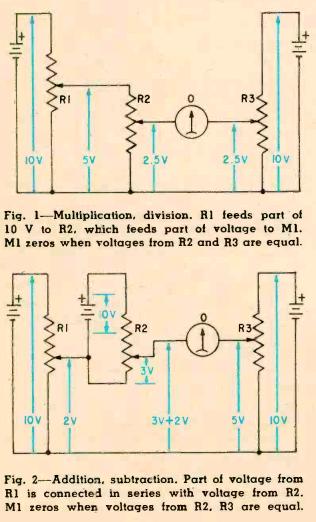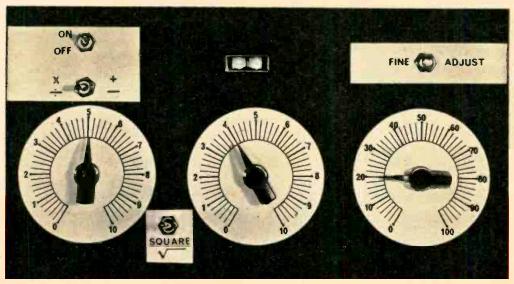Fifty years ago, you would probably be the only one on your block with a computer if you built one of these. The January 1966 issue of Electronics Illustrated contains the plans for building this analog computer, suitable for addition, subtraction, multiplication, division, squares, and square roots.
Each dial is calibrated from 0-10, and there is a small ammeter. For an addition problem, you set the switch to +/-, and adjust the two left knobs to show the numbers you want to add. Then, you adjust the right knob until the meter is at zero. Subtraction problems are done in the same fashion, except you set the right knob to the larger number, the middle knob to the smaller number, and the answer is shown on the left knob when the meter reads zero. A similar procedure is used to do multiplication and division. In the image shown above, the computer confirms that 5 times 4 does indeed equal 20.
For squares and square roots, a second section of one of the dual potentiometers is used so that both have the same resistance. That dial shows a number, and the dial on the right shows its square.
The article points out that the device is basically the electronic equivalent of a slide rule (and probably much less accurate). And like with a slide rule, you were on your own when it came to figuring out where the decimal point went.
I do remember in the elementary school library a book showing a similar contraption, which was wired up only for addition. Instead of having three potentiometers and a meter used only for zeroing, it had two potentiometers and a meter from which the answer was read. Despite thinking about how much easier that would make my math homework, that setup was probably much less accurate than the one shown here.
 Shown here are simplified schematics showing the circuit used for addition and multiplication. The combined wiring diagram showing the switches is, of course, also included in the article. But the simplified diagrams give a good idea of how the thing works. Both merely take advantage of Ohm’s law. R1 and R2 are one tenth the value of R3. As might be guessed, the parts list calls for linear tapered potentiometers.
Shown here are simplified schematics showing the circuit used for addition and multiplication. The combined wiring diagram showing the switches is, of course, also included in the article. But the simplified diagrams give a good idea of how the thing works. Both merely take advantage of Ohm’s law. R1 and R2 are one tenth the value of R3. As might be guessed, the parts list calls for linear tapered potentiometers.
Click Here For Today’s Ripley’s Believe It Or Not Cartoon
![]()


My husband and i were so ecstatic that Peter managed to round up his reports from the precious recommendations he had in your web site. It is now and again perplexing to simply always be giving out tricks that people today might have been selling. So we already know we now have the website owner to thank for that. The explanations you’ve made, the easy web site navigation, the relationships you will aid to engender – it’s got mostly fabulous, and it’s helping our son in addition to our family consider that the situation is cool, which is certainly pretty mandatory. Thanks for the whole thing!
Well, thank you! I’m glad Peter was able to get his analog computer up and running. I appreciate your comment very much.
Oh, but believe it or not, sometimes people spam the comments so that they can get links back to irrelevant websites. So I hope you understand that I deleted your link. 🙂